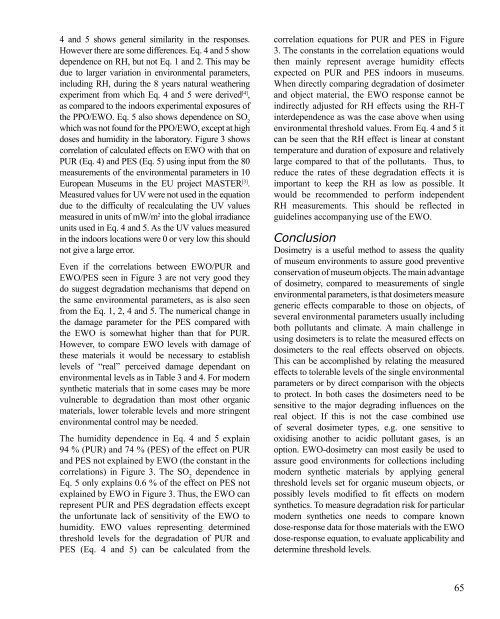dk nkf - Nordisk Konservatorforbund Danmark
dk nkf - Nordisk Konservatorforbund Danmark
dk nkf - Nordisk Konservatorforbund Danmark
Create successful ePaper yourself
Turn your PDF publications into a flip-book with our unique Google optimized e-Paper software.
4 and 5 shows general similarity in the responses.<br />
However there are some differences. Eq. 4 and 5 show<br />
dependence on RH, but not Eq. 1 and 2. This may be<br />
due to larger variation in environmental parameters,<br />
including RH, during the 8 years natural weathering<br />
experiment from which Eq. 4 and 5 were derived [4] ,<br />
as compared to the indoors experimental exposures of<br />
the PPO/EWO. Eq. 5 also shows dependence on SO 2<br />
which was not found for the PPO/EWO, except at high<br />
doses and humidity in the laboratory. Figure 3 shows<br />
correlation of calculated effects on EWO with that on<br />
PUR (Eq. 4) and PES (Eq. 5) using input from the 80<br />
measurements of the environmental parameters in 10<br />
European Museums in the EU project MASTER [3] .<br />
Measured values for UV were not used in the equation<br />
due to the difficulty of recalculating the UV values<br />
measured in units of mW/m 2 into the global irradiance<br />
units used in Eq. 4 and 5. As the UV values measured<br />
in the indoors locations were 0 or very low this should<br />
not give a large error.<br />
Even if the correlations between EWO/PUR and<br />
EWO/PES seen in Figure 3 are not very good they<br />
do suggest degradation mechanisms that depend on<br />
the same environmental parameters, as is also seen<br />
from the Eq. 1, 2, 4 and 5. The numerical change in<br />
the damage parameter for the PES compared with<br />
the EWO is somewhat higher than that for PUR.<br />
However, to compare EWO levels with damage of<br />
these materials it would be necessary to establish<br />
levels of “real” perceived damage dependant on<br />
environmental levels as in Table 3 and 4. For modern<br />
synthetic materials that in some cases may be more<br />
vulnerable to degradation than most other organic<br />
materials, lower tolerable levels and more stringent<br />
environmental control may be needed.<br />
The humidity dependence in Eq. 4 and 5 explain<br />
94 % (PUR) and 74 % (PES) of the effect on PUR<br />
and PES not explained by EWO (the constant in the<br />
correlations) in Figure 3. The SO 2 dependence in<br />
Eq. 5 only explains 0.6 % of the effect on PES not<br />
explained by EWO in Figure 3. Thus, the EWO can<br />
represent PUR and PES degradation effects except<br />
the unfortunate lack of sensitivity of the EWO to<br />
humidity. EWO values representing determined<br />
threshold levels for the degradation of PUR and<br />
PES (Eq. 4 and 5) can be calculated from the<br />
correlation equations for PUR and PES in Figure<br />
3. The constants in the correlation equations would<br />
then mainly represent average humidity effects<br />
expected on PUR and PES indoors in museums.<br />
When directly comparing degradation of dosimeter<br />
and object material, the EWO response cannot be<br />
indirectly adjusted for RH effects using the RH-T<br />
interdependence as was the case above when using<br />
environmental threshold values. From Eq. 4 and 5 it<br />
can be seen that the RH effect is linear at constant<br />
temperature and duration of exposure and relatively<br />
large compared to that of the pollutants. Thus, to<br />
reduce the rates of these degradation effects it is<br />
important to keep the RH as low as possible. It<br />
would be recommended to perform independent<br />
RH measurements. This should be reflected in<br />
guidelines accompanying use of the EWO.<br />
Conclusion<br />
Dosimetry is a useful method to assess the quality<br />
of museum environments to assure good preventive<br />
conservation of museum objects. The main advantage<br />
of dosimetry, compared to measurements of single<br />
environmental parameters, is that dosimeters measure<br />
generic effects comparable to those on objects, of<br />
several environmental parameters usually including<br />
both pollutants and climate. A main challenge in<br />
using dosimeters is to relate the measured effects on<br />
dosimeters to the real effects observed on objects.<br />
This can be accomplished by relating the measured<br />
effects to tolerable levels of the single environmental<br />
parameters or by direct comparison with the objects<br />
to protect. In both cases the dosimeters need to be<br />
sensitive to the major degrading influences on the<br />
real object. If this is not the case combined use<br />
of several dosimeter types, e.g. one sensitive to<br />
oxidising another to acidic pollutant gases, is an<br />
option. EWO-dosimetry can most easily be used to<br />
assure good environments for collections including<br />
modern synthetic materials by applying general<br />
threshold levels set for organic museum objects, or<br />
possibly levels modified to fit effects on modern<br />
synthetics. To measure degradation risk for particular<br />
modern synthetics one needs to compare known<br />
dose-response data for those materials with the EWO<br />
dose-response equation, to evaluate applicability and<br />
determine threshold levels.<br />
65

















